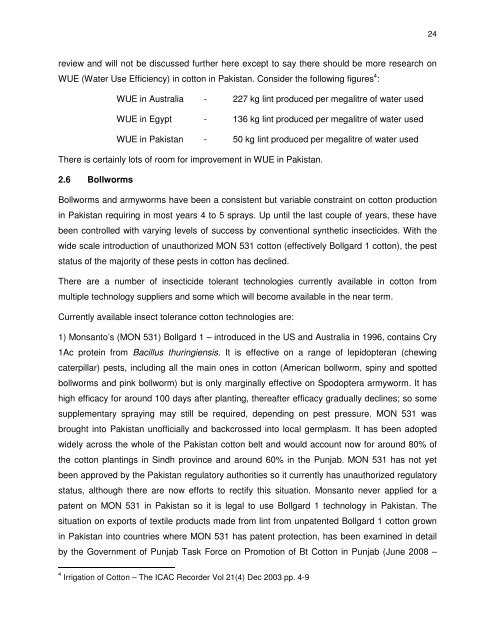ChangingCottonLandscapeNeilForrester
ChangingCottonLandscapeNeilForrester
ChangingCottonLandscapeNeilForrester
Create successful ePaper yourself
Turn your PDF publications into a flip-book with our unique Google optimized e-Paper software.
eview and will not be discussed further here except to say there should be more research on<br />
WUE (Water Use Efficiency) in cotton in Pakistan. Consider the following figures 4 :<br />
WUE in Australia - 227 kg lint produced per megalitre of water used<br />
WUE in Egypt - 136 kg lint produced per megalitre of water used<br />
WUE in Pakistan - 50 kg lint produced per megalitre of water used<br />
There is certainly lots of room for improvement in WUE in Pakistan.<br />
2.6 Bollworms<br />
Bollworms and armyworms have been a consistent but variable constraint on cotton production<br />
in Pakistan requiring in most years 4 to 5 sprays. Up until the last couple of years, these have<br />
been controlled with varying levels of success by conventional synthetic insecticides. With the<br />
wide scale introduction of unauthorized MON 531 cotton (effectively Bollgard 1 cotton), the pest<br />
status of the majority of these pests in cotton has declined.<br />
There are a number of insecticide tolerant technologies currently available in cotton from<br />
multiple technology suppliers and some which will become available in the near term.<br />
Currently available insect tolerance cotton technologies are:<br />
1) Monsanto’s (MON 531) Bollgard 1 – introduced in the US and Australia in 1996, contains Cry<br />
1Ac protein from Bacillus thuringiensis. It is effective on a range of lepidopteran (chewing<br />
caterpillar) pests, including all the main ones in cotton (American bollworm, spiny and spotted<br />
bollworms and pink bollworm) but is only marginally effective on Spodoptera armyworm. It has<br />
high efficacy for around 100 days after planting, thereafter efficacy gradually declines; so some<br />
supplementary spraying may still be required, depending on pest pressure. MON 531 was<br />
brought into Pakistan unofficially and backcrossed into local germplasm. It has been adopted<br />
widely across the whole of the Pakistan cotton belt and would account now for around 80% of<br />
the cotton plantings in Sindh province and around 60% in the Punjab. MON 531 has not yet<br />
been approved by the Pakistan regulatory authorities so it currently has unauthorized regulatory<br />
status, although there are now efforts to rectify this situation. Monsanto never applied for a<br />
patent on MON 531 in Pakistan so it is legal to use Bollgard 1 technology in Pakistan. The<br />
situation on exports of textile products made from lint from unpatented Bollgard 1 cotton grown<br />
in Pakistan into countries where MON 531 has patent protection, has been examined in detail<br />
by the Government of Punjab Task Force on Promotion of Bt Cotton in Punjab (June 2008 –<br />
4 Irrigation of Cotton – The ICAC Recorder Vol 21(4) Dec 2003 pp. 4-9<br />
24


